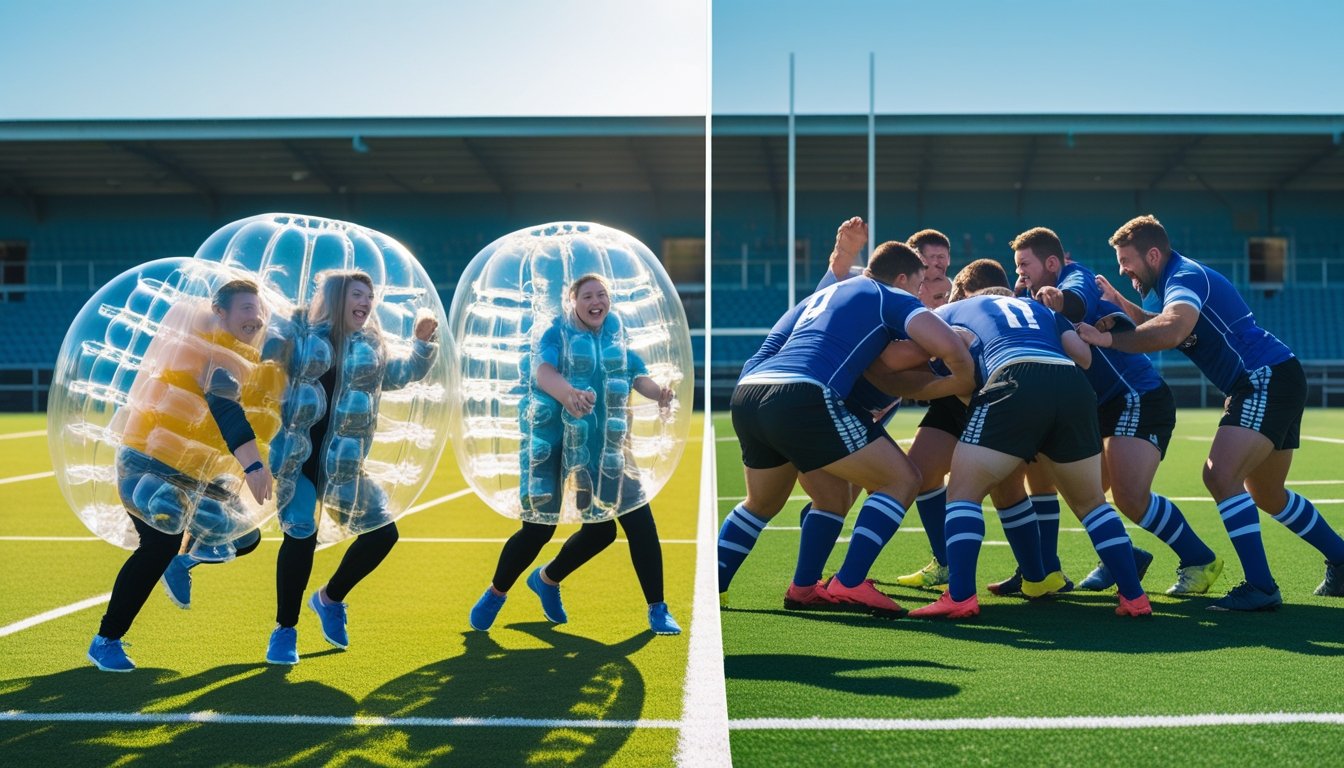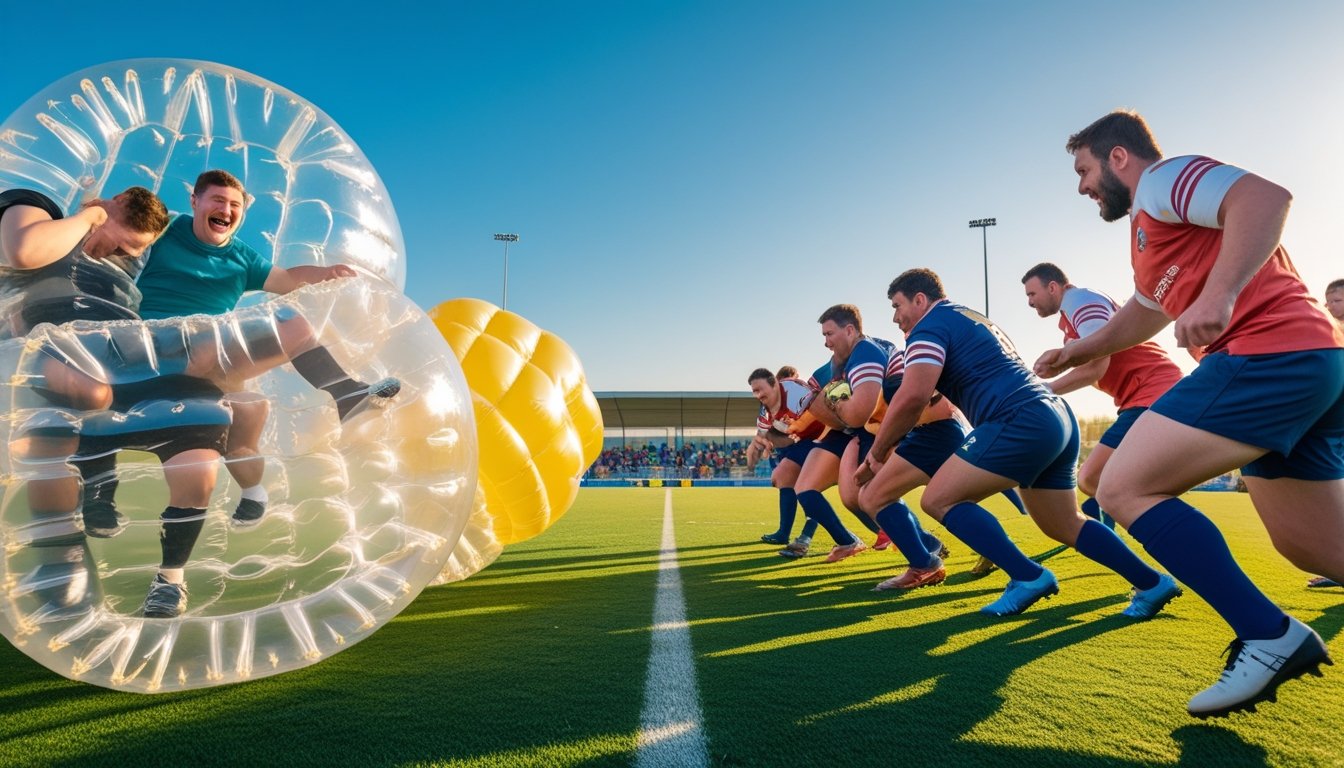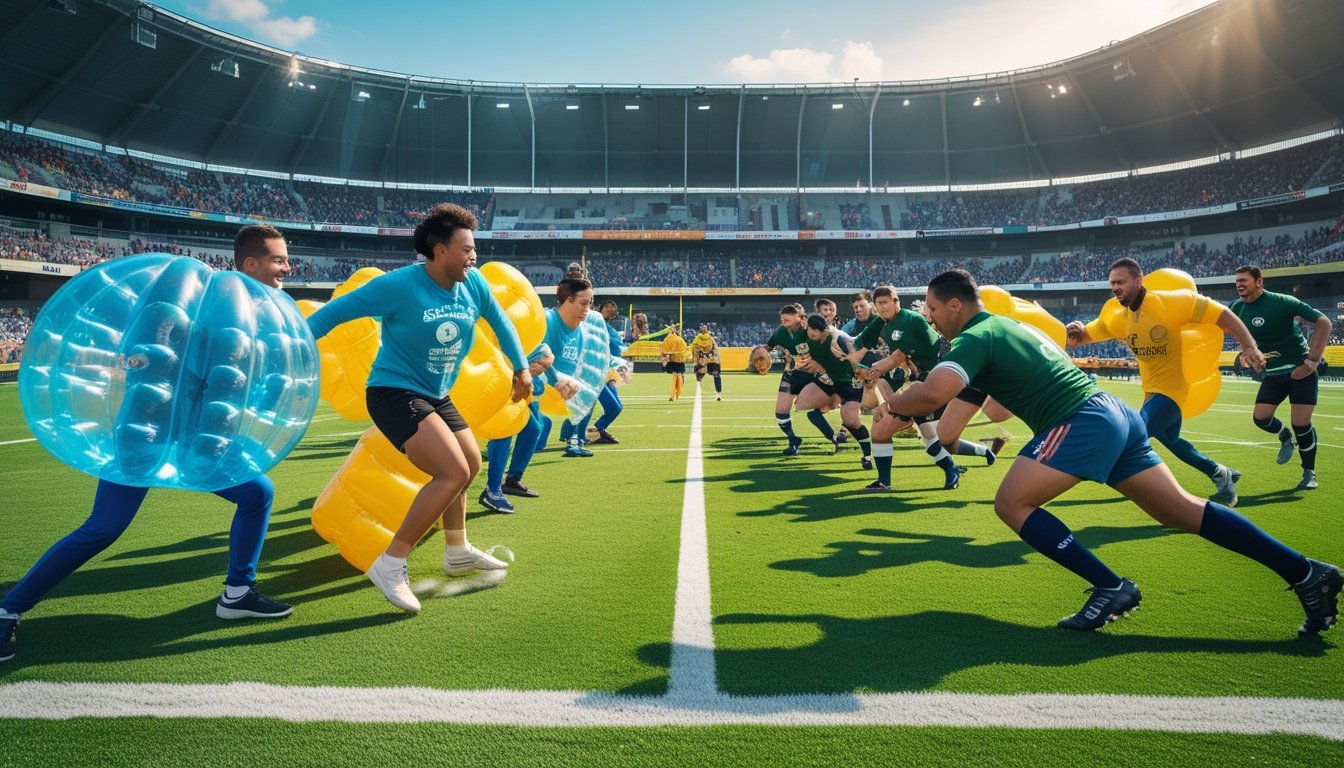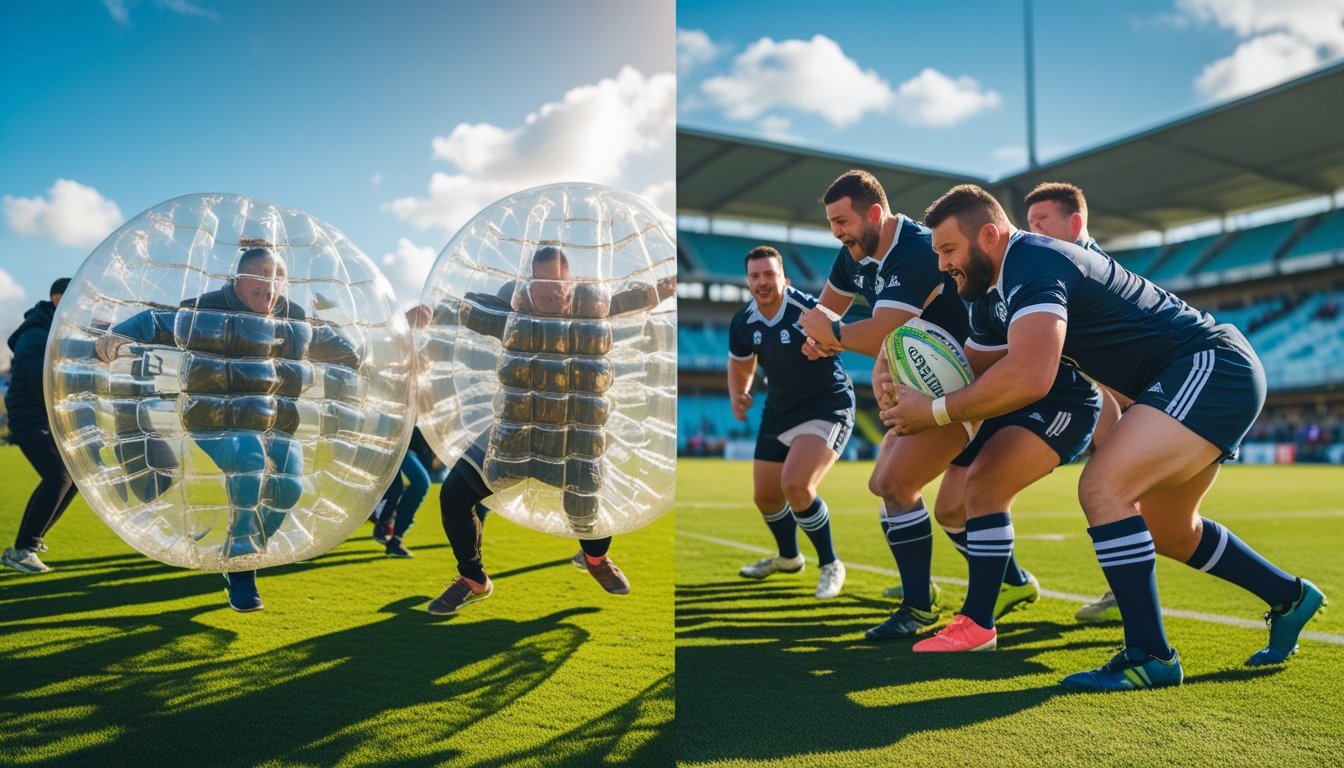Late updated: 14 May 2025 15:05
Written by: Emma Saunders
Bubble Football Versus Rugby: An In-Depth Comparison
Exploring the dynamic world of sports, we find a curious scenario when comparing bubble football and rugby. Bubble football, a modern twist on traditional football, brings a playful spirit into the game, with players encased in zorb-like bubbles bouncing off one another. Rugby, in contrast, is a game steeped in tradition, known for its physical intensity and intricate rules. The core question beckoning us is: how do these two sports, so different in nature, align and diverge in terms of play, appeal, and impact?

As we delve deeper, bubble football emerges as an entertaining and accessible sport for those seeking fun with minimal risk, thanks to the protective bubble equipment. This contrasts with the intensity of rugby, where the absence of pads and helmets increases the physical demands on players. Cultural contexts also differ markedly; rugby enjoys a prominent place in many societies as a revered sport, whereas bubble football is generally viewed as a recreational activity with growing popularity.
Key Takeaways
- Bubble football offers playful, low-risk entertainment while rugby demands intense physical effort.
- Rugby holds cultural significance, while bubble football is accessible and family-friendly.
- Both sports enjoy their own unique commercial landscape with differing levels of mainstream appeal.
Key Differences Between Bubble Football and Rugby

In examining bubble football and rugby, we focus on several core distinctions: the rules that govern gameplay, the level and nature of physical contact, equipment used, the playing surface, as well as the team composition and strategic approaches. Each aspect highlights unique challenges and dynamics.
Gameplay Rules and Objective
Bubble football, similar to soccer, involves manoeuvring an inflated ball into the opposing team's goal while encased in a large inflatable bubble for added safety. Matches typically last about 60 minutes, divided into shorter halves. The primary aim is to have fun and score goals.
In contrast, rugby combines speed, agility, and strength with the objective of carrying the ball over the opponent's goal line or kicking it between the goalposts. With specific formations such as scrums and line-outs, rugby requires strategic positioning and precise execution.
Physical Contact and Injury Risk
Bubble football's design significantly reduces injury risks. The inflatable bubbles cushion players from impacts, allowing for considerable jostling without serious harm. While accidental falls are common, players are mostly protected from direct collisions.
Rugby, however, is renowned for its physicality. Players engage in vigorous tackles, and it is common for matches to feature intense bodily contact. The risk of injury is higher, with common occurrences including sprains, concussions, and fractures. This necessitates adequate protective gear despite its lack of traditional padding compared to American football.
Equipment and Playing Surface
In bubble football, each participant wears an inflatable bubble suit, protecting the upper body and head, while leaving legs free for movement. The game is generally played on flat surfaces such as indoor courts or soft grass fields to mitigate impact injuries from falls.
Rugby requires minimal equipment: a jersey, shorts, boots, and mouthguard. Players compete on grassy pitches and must adapt to varying ground conditions that can influence gameplay dynamics, adding an extra strategic layer.
Team Size and Strategy
Bubble football teams are compact, typically consisting of five players. This smaller size encourages dynamic play with rapid turnovers akin to five-a-side soccer, prioritising agility and quick decision-making on the field.
Rugby teams usually have 15 players. This larger number allows for complex strategies and varied roles, like forwards for scrummaging and backs for running plays. Teamwork is crucial, as coordinated efforts in offence and defence can shift the tide of the match, demanding a higher level of strategic collaboration.
Cultural Impact, Accessibility, and Commercialisation

Examining the cultural significance and accessibility of bubble football compared to rugby reveals intriguing contrasts. These differences extend into commercialisation avenues including audience interest, coaching methods, media presence, and sponsorships.
Popularity and Audience Demographics
The global appeal of rugby is undeniable, with its long-standing traditions and international recognition through events such as the Rugby World Cup. Rugby draws a diverse audience from various regions, contributing to its widespread fan base.
On the other hand, bubble football is emerging as a recreational sport with a more niche, youthful audience. Its appeal lies in the novelty and entertainment value, resonating particularly with a younger crowd seeking unorthodox sports experiences, making it an exciting option for local festivals and community sports days.
Coaching and Player Development
Coaching in rugby is a well-established practice with robust training programs focusing on skill development and strategic gameplay. Many countries have structured coaching certifications aimed at enhancing the quality of sport.
Bubble football, contrastingly, is still evolving in terms of coaching methodologies. The emphasis remains on safety and enjoyment rather than formal skills development. As it grows, we anticipate more systematic coaching initiatives similar to other team sports, likely borrowing elements from football and rugby frameworks to structure training sessions effectively.
Media Coverage and Streaming Platforms
Rugby's media coverage is extensive, with numerous matches broadcast on major television networks and several streaming platforms. These media outlets provide comprehensive analyses and live commentary, enhancing the sport's global accessibility.
Bubble football, with its novelty factor, has been gaining traction on social media and video streaming platforms. While traditional media has yet to capture its essence fully, the viral nature of bubble football videos contributes significantly to its spread. This forms an integral part of its commercialisation, tapping into digital content consumption trends.
Sponsorship Opportunities
Rugby enjoys substantial financial backing from leading corporate sponsors eager to associate with its international prestige. These sponsorships are pivotal in funding sporting events and grassroots programmes, promoting development and accessibility across different regions.
Bubble football, although less established in terms of large-scale sponsorships, presents novel opportunities for local businesses and niche brands. Its accessible nature and community-driven events attract sponsors looking to reach younger demographics and localised markets, potentially fostering collaborations that benefit community engagement and local economic growth.
Frequently Asked Questions

In our analysis of bubble football and rugby, we assess key distinctions in rules, injury rates, field differences, equipment, physical demands, and safety considerations.
What are the primary distinctions between the rules of rugby and bubble football?
Rugby rules focus on continuous play and strategy-oriented movement with specific roles. Bubble football shares a set-up similar to traditional football but emphasises fun and informal play, with players encased in inflatable bubbles for safety and entertainment. Scoring methods and legal tackling techniques differ significantly between the two sports.
Which sport reports a higher incidence of injury, rugby or football, according to recent studies?
Recent studies suggest that rugby experiences a higher injury incidence compared to traditional football. The physical nature and complexity of rugby contribute to this increased risk. Bubble football, given its playful nature and protective equipment, tends to report fewer injuries, as the use of inflatable bubbles provides additional protection during play.
In what ways do the playing fields for rugby and bubble football differ?
Rugby is played on a large grass field, usually around 100 meters long, with designated lines for scoring and tactical manoeuvres. Bubble football, in contrast, can be played indoors or outdoors on various surfaces and generally requires a smaller field. The flexibility of bubble football venues allows for more varied playing environments.
How does the equipment used in rugby compare with that utilised in bubble football?
Rugby players rely on minimal protective gear, such as mouthguards and scrum caps, promoting agility. In comparison, bubble football players wear inflated bubbles covering their upper bodies, offering enhanced protection. The bubbles cushion players during impacts, making injuries less frequent and the sport more accessible for a wider range of participants.
Is there a significant difference in the physical demand and intensity between rugby and bubble football?
Rugby is intense and physically demanding, requiring strength, agility, and endurance. It demands considerable physical exertion over extended periods. Bubble football is less physically demanding, focusing on enjoyment and shorter bursts of activity. The protective bubbles limit high-impact collisions, enabling a more relaxed experience with lower intensity levels.
What relevant factors should be considered when comparing the safety of rugby and bubble football?
When comparing safety, consider the role of equipment, the intensity of physical contact, and the potential for injury. Rugby involves higher contact levels with less protective gear, increasing injury risk. Bubble football employs protective bubbles that absorb impacts, reducing risk and making the sport safer. Safety standards and rules in both sports further influence player protection.
